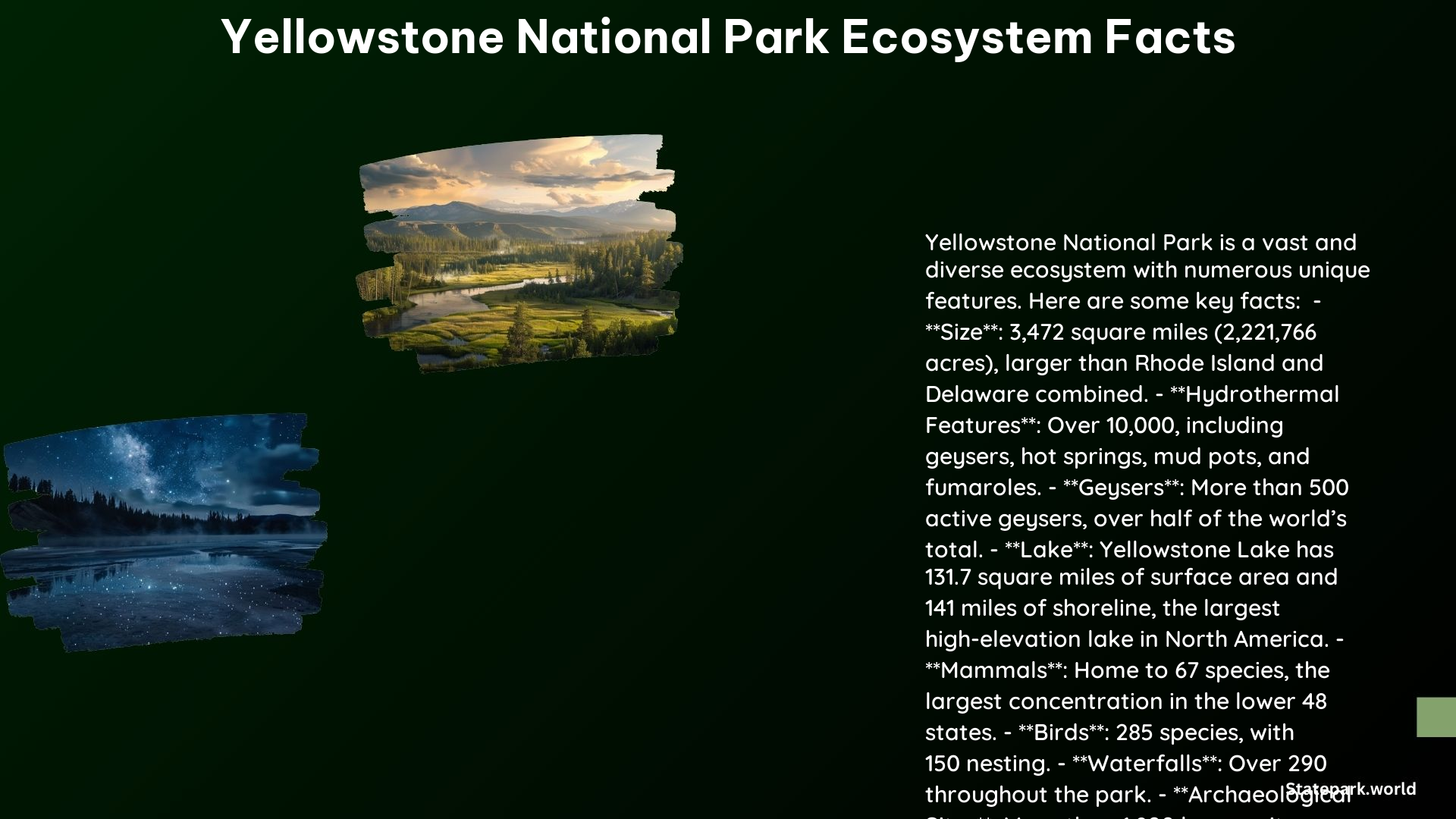Yellowstone National Park is a vast and diverse ecosystem that encompasses a wide range of natural wonders and wildlife. From its massive size and active volcanic activity to its abundant wildlife and changing climate, the Yellowstone ecosystem is a fascinating and complex natural wonder.
The Size of Yellowstone National Park Ecosystem
Yellowstone National Park covers an area of 3,472 square miles (8,991 km²), making it larger than the states of Rhode Island and Delaware combined. This vast expanse of land is home to a diverse array of ecosystems, including forests, grasslands, and hydrothermal features.
Geological Wonders of Yellowstone

Yellowstone sits on top of an active volcano, with one of the world’s largest calderas measuring 45 x 30 miles (72 x 48 km). The park experiences 1,000–3,000 earthquakes annually and has over 10,000 hydrothermal features, including more than 500 active geysers. These geological wonders are a testament to the dynamic and ever-changing nature of the Yellowstone ecosystem.
Abundant Wildlife in Yellowstone
The Yellowstone National Park ecosystem is home to an incredible variety of wildlife, including 67 species of mammals, 285 species of birds, 16 species of fish, 5 species of amphibians, and 6 species of reptiles. It has the largest concentration of mammals in the lower 48 states, making it a prime destination for wildlife enthusiasts.
Diverse Vegetation in Yellowstone
The park’s forests are dominated by lodgepole pine, with over 1,000 species of native flowering plants and 225 species of invasive plants. This diverse vegetation supports the park’s abundant wildlife and contributes to the overall health of the Yellowstone ecosystem.
Changing Climate in Yellowstone
Yellowstone’s climate is changing, with a continued rise in temperature expected to fundamentally alter the ecosystem. The park experiences a wide range of temperatures, from -66°F (-54°C) to 99°F (37°C), and these fluctuations can have significant impacts on the park’s wildlife and vegetation.
Abundant Water Resources in Yellowstone
Yellowstone Lake is the largest high-elevation lake in North America, with a surface area of 131.7 square miles (341.1 km²) and 141 miles (227 km) of shoreline. The park has over 290 waterfalls, with the tallest being the Lower Falls of the Yellowstone River at 308 feet (94 m). These water resources are essential for the park’s diverse ecosystems.
Cultural Significance of Yellowstone
The park has a rich cultural heritage, with 26 associated Native American tribes and over 1,800 known archaeological sites. It also houses more than 720,000 museum items, including historic vehicles, documents, and books, highlighting the importance of Yellowstone to human history and culture.
The Greater Yellowstone Ecosystem
Yellowstone is part of the Greater Yellowstone Ecosystem, which spans over 28,000 square miles (72,520 km²) and is one of the largest nearly intact temperate-zone ecosystems on Earth. This vast ecosystem is home to a diverse range of terrestrial, aquatic, and microbial life, making it a critical natural resource.
Conservation Efforts in Yellowstone
The park is managed to preserve its natural state, with efforts focused on protecting wildlife habitats, managing land use, and addressing climate change. The National Park Service and other organizations work together to ensure the long-term health of the Yellowstone ecosystem.
Tourism in Yellowstone
Yellowstone is a popular tourist destination, with over 4 million visitors annually. The park has 11 visitor centers, museums, and contact stations, as well as numerous hotels, campgrounds, and trails for visitors to explore and experience the wonders of the Yellowstone ecosystem.
References:
– National Park Service. (2020). Greater Yellowstone Ecosystem. Retrieved from https://www.nps.gov/yell/learn/nature/greater-yellowstone-ecosystem.htm
– National Wildlife Federation. (n.d.). Yellowstone. Retrieved from https://www.nwf.org/Educational-Resources/Wildlife-Guide/Wild-Places/Yellowstone
– Yellowstone National Park. (n.d.). Yellowstone National Park Facts. Retrieved from https://www.yellowstone.org/experience/visitor-information/yellowstone-national-park-facts/
– National Park Service. (2023). Nature – Yellowstone National Park. Retrieved from https://www.nps.gov/yell/learn/nature/index.htm
– Yellowstone National Park. (2023). 10 Great Big Yellowstone Facts. Retrieved from https://www.yellowstone.org/10-yellowstone-facts/
